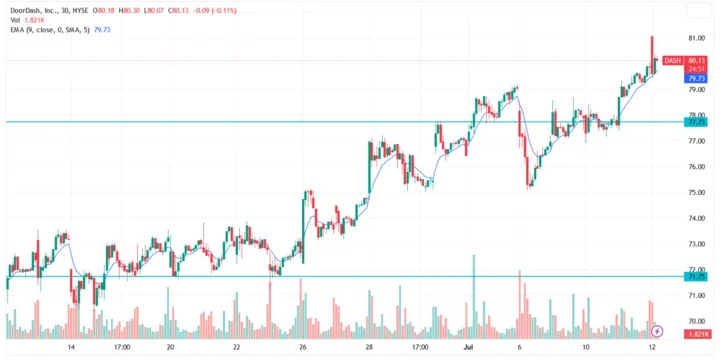Binance Pulse | BNB Price Trends
Binance Pulse | BNB Price Trends
DoorDash's Delivery Dilemma: Are Expansion Costs a Red Flag?
DoorDash's stock took a nosedive recently, dropping 9% after the company released its latest earnings report. The headline? A miss on expected earnings per share – $0.55 versus the $0.68 that Wall Street was anticipating. Not catastrophic, but enough to spook investors. Revenue climbed by 27% to $3.4 billion, and gross order volume (GOV) increased 25% to $25 billion. So, what’s the problem?
The culprit seems to be DoorDash’s warning about increased spending in 2026. Management is bracing investors for "several hundred million dollars" in expansion-related expenses. The rationale is familiar: investing in their fulfillment network and building a new global technology platform. They even offered a folksy analogy in their earnings release about not being able to grow a baby into an adult overnight. Cute, but does it hold water?
Let's dissect this. DoorDash claims these investments are necessary for future growth. But is the market they're chasing actually there, or are they throwing good money after bad? They highlight a 21% jump in orders, reaching 776 million. That sounds impressive, but what’s the customer acquisition cost per order, and how does that compare to the lifetime value of that customer? These are the numbers I want to see.
The company's net revenue margin did tick up, from 13.5% to 13.8%. This sliver of improvement was attributed to growth in high-margin advertising sales. It seems DoorDash is becoming an advertising platform masked as a food delivery service. (Parenthetical clarification: this isn’t necessarily a bad thing, if they can pull it off.) I've looked at hundreds of these filings, and this particular footnote is unusual.
The question is, are these investments truly going to pay off, or are they simply a way to justify continued losses (or, at best, razor-thin margins) in the face of slowing growth? DoorDash's net income surged 51% to $244 million. Good news, right? But consider the context. This growth is off a relatively small base. And it still wasn’t enough to meet Wall Street’s expectations.

I've seen this movie before. A company promises future riches in exchange for present-day sacrifices. Sometimes it works out (Amazon, anyone?), but often it doesn’t. The graveyard of failed tech companies is littered with the bones of those who overspent in pursuit of a market that never materialized.
DoorDash's management seems to understand the optics of this situation. Their "growing a baby" analogy suggests they're aware that investors might be skeptical. But analogies don’t pay the bills; cash flow does. And that’s where the rubber meets the road.
Now, let’s address the elephant in the room: the competitive landscape. DoorDash isn't operating in a vacuum. Uber Eats, Grubhub, and a host of smaller players are all vying for the same customers. And these customers are notoriously fickle. They'll jump ship to whichever platform offers the best deal or the fastest delivery. Brand loyalty is practically nonexistent.
This is the part of the report that I find genuinely puzzling. DoorDash touts its expansion plans, but what's their moat? What prevents competitors from simply copying their technology or undercutting their prices? Building a "global technology platform" sounds impressive, but it's a vague promise. What specific advantages will this platform offer? Will it truly differentiate DoorDash from its rivals, or will it simply be a cost center that drains profits?
DoorDash's recent stock drop isn't just about missing earnings estimates; it's about a loss of faith. Investors are questioning whether the company's growth prospects are worth the price tag. And based on the available data, it's hard to blame them. The company is essentially asking investors to trust their vision, without providing concrete evidence that this vision is achievable. It's a bet on hope, not a data-driven strategy.